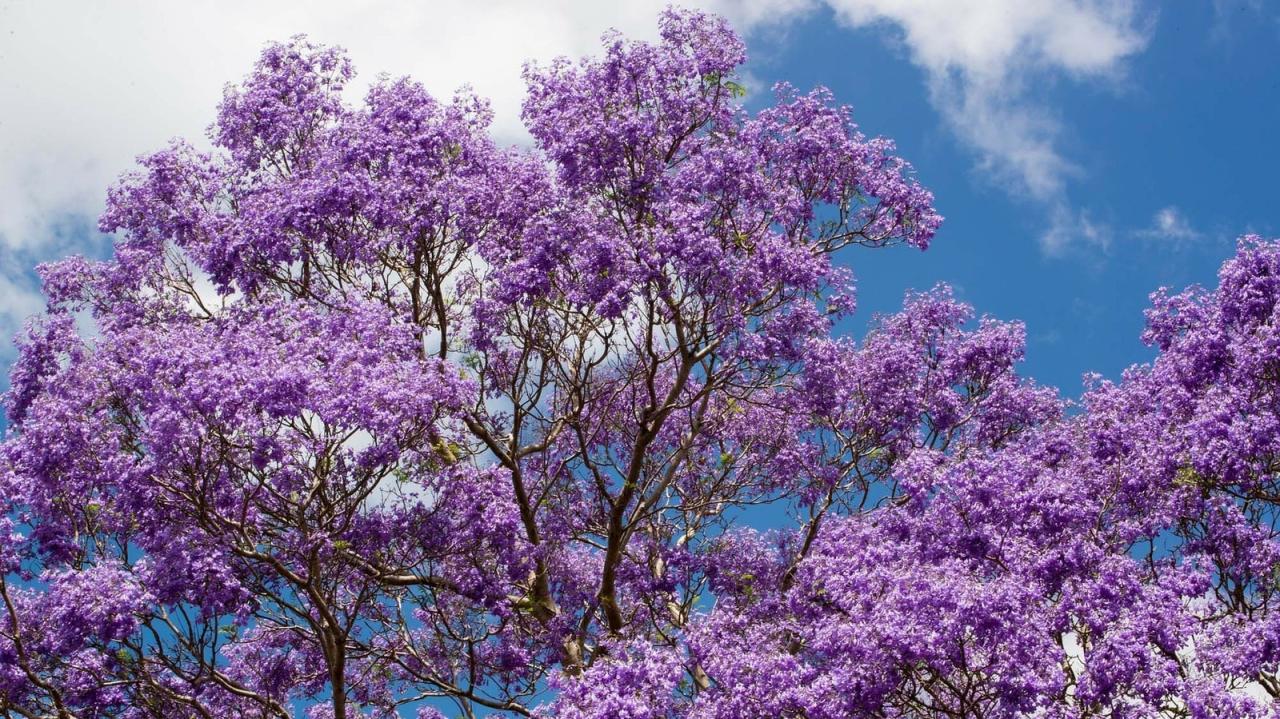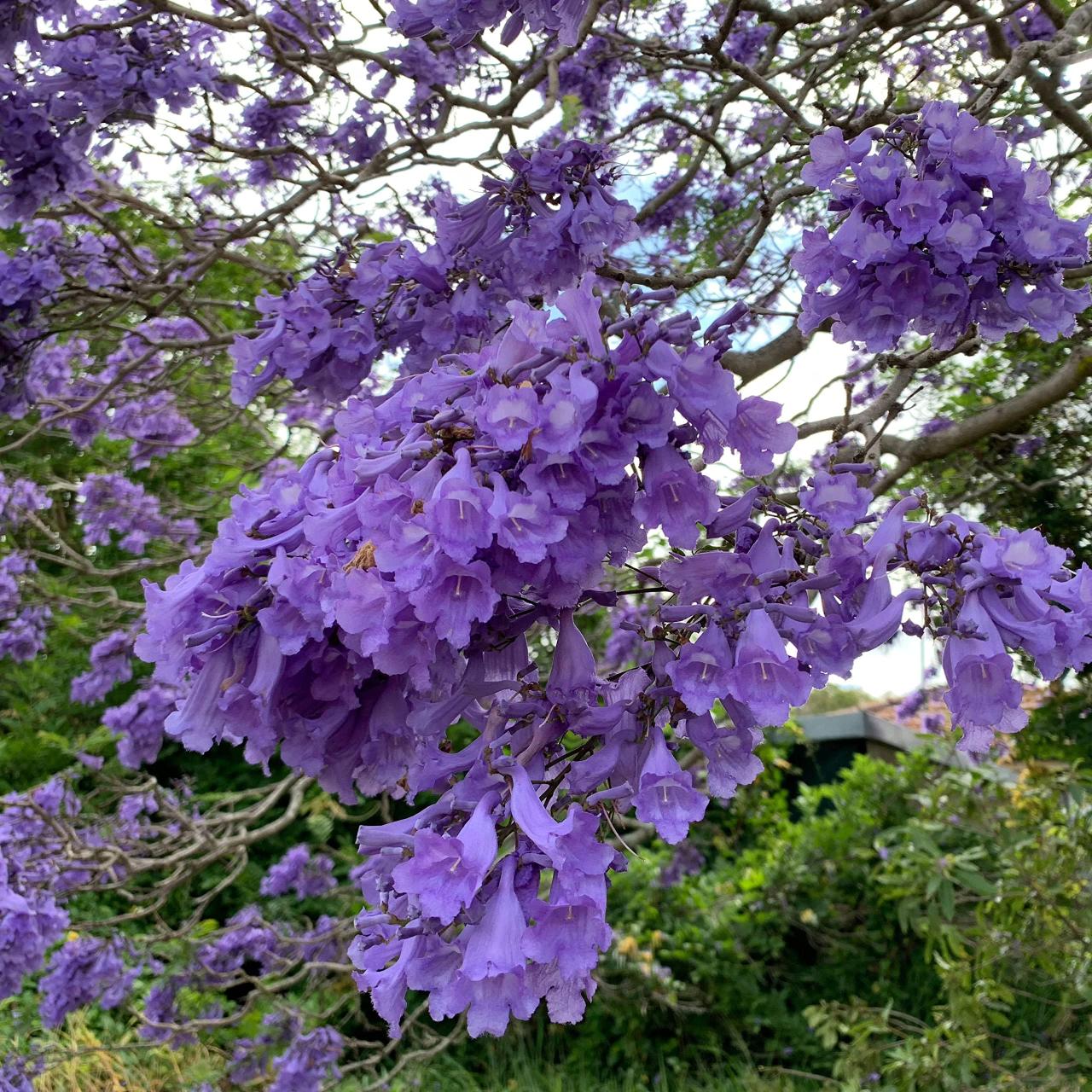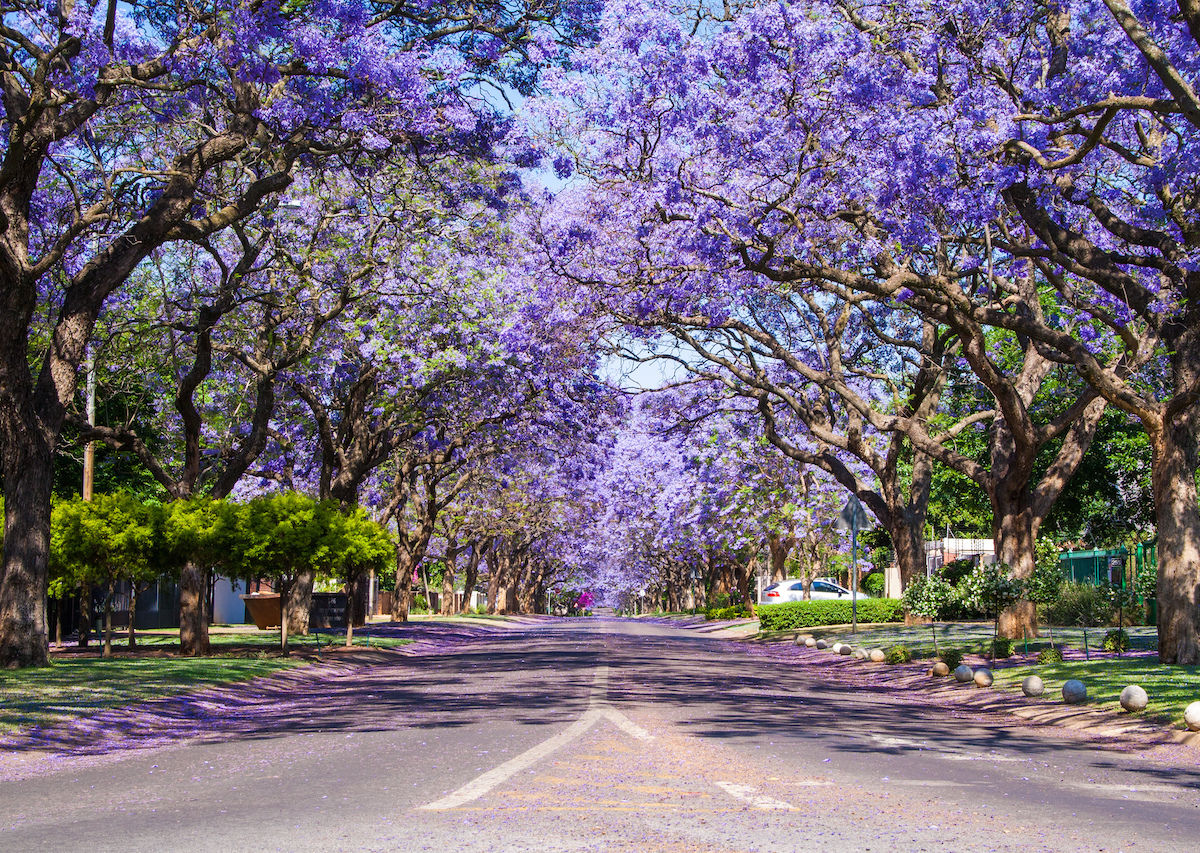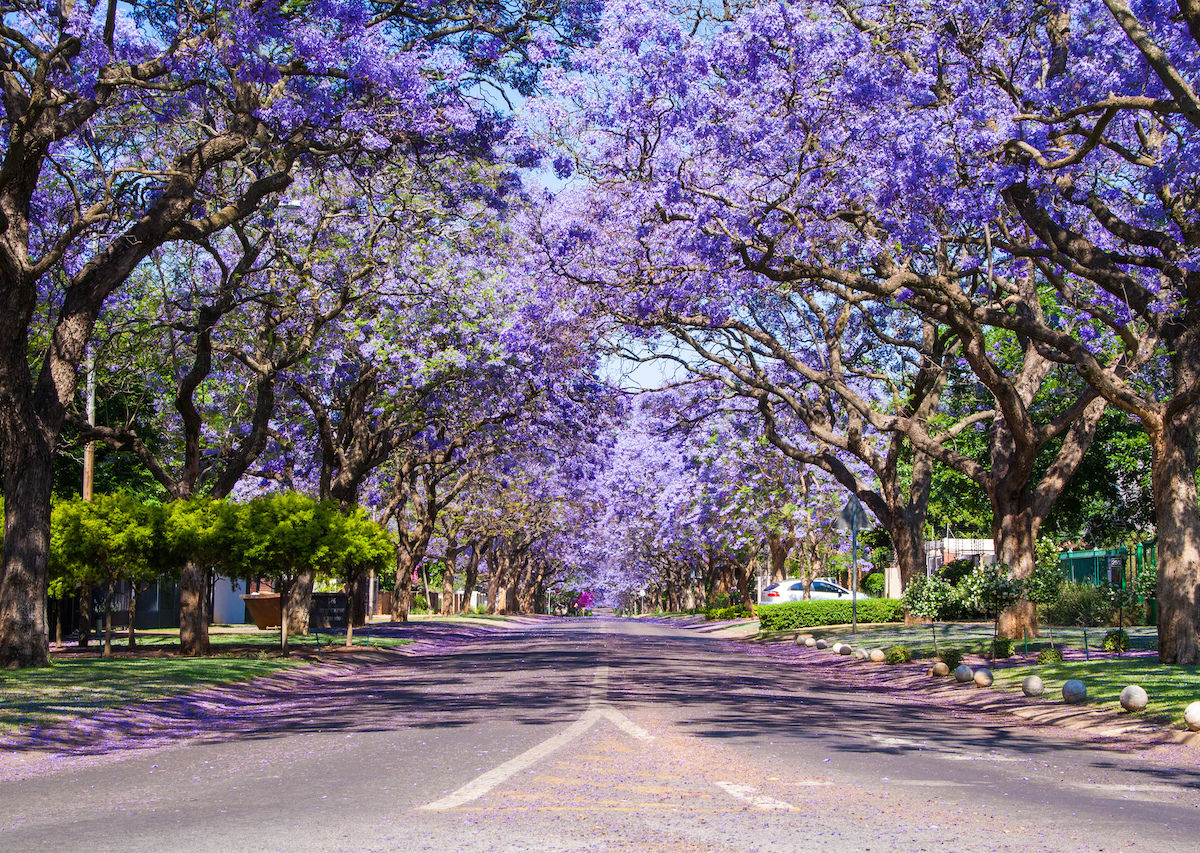How to Cultivate Jacaranda Tree for Maximum Beauty: Expert Tips for Vibrant Blooms – Cultivating Jacaranda Tree for Maximum Beauty: Expert Tips for Vibrant Blooms, a vibrant tapestry of purple blossoms against a backdrop of lush green foliage, Jacaranda trees are a captivating sight. Their beauty, however, goes beyond mere aesthetics. These trees, native to South America, are known for their resilience and adaptability, thriving in various climates with proper care.
Understanding the specific needs of Jacaranda trees is key to unlocking their full potential, ensuring a bountiful display of vibrant blooms year after year.
From selecting the ideal growing conditions to implementing effective pruning techniques, this guide delves into the art of cultivating Jacaranda trees for maximum beauty. We’ll explore the intricate details of planting, establishing, and nurturing these trees, providing expert tips and tricks to help you achieve a truly breathtaking landscape.
Join us as we embark on a journey to cultivate a vibrant Jacaranda paradise.
Jacaranda Tree Basics: How To Cultivate Jacaranda Tree For Maximum Beauty: Expert Tips For Vibrant Blooms
The Jacaranda tree, scientifically known as Jacaranda mimosifolia, is a captivating sight, especially during its blooming season. Originating from South America, specifically Brazil, Argentina, and Bolivia, this tree has become a beloved ornamental species worldwide. It is known for its striking beauty and captivating blooms, adding a vibrant touch to landscapes.
However, to cultivate a Jacaranda tree successfully, understanding its specific needs is crucial.
Jacaranda Tree Characteristics
Jacaranda trees are typically medium-sized, reaching heights of 40-60 feet with a spread of 30-50 feet. Their growth habit is characterized by a rounded, open canopy, creating a picturesque silhouette. One of the most notable features of Jacaranda trees is their stunning display of vibrant, lavender-blue flowers.
These flowers, which resemble delicate bells, appear in large clusters at the ends of branches, transforming the tree into a breathtaking spectacle. The blooms are a testament to the tree’s unique beauty and contribute significantly to its popularity as an ornamental species.
Creating a visually stunning garden often involves a mix of textures and colors, from the vibrant blooms of a Jacaranda tree to the unique architectural beauty of a papyrus plant. While the Jacaranda thrives in full sun and well-drained soil, the papyrus plant, with its striking resemblance to ancient Egyptian scrolls, prefers moist, even boggy conditions.
To learn more about caring for this fascinating plant, explore Papyrus Plant Care Tips: How to Maintain a Beautiful and Unique Garden Feature , and then return to the tips for cultivating your Jacaranda for maximum beauty.
Jacaranda Tree Needs
Jacaranda trees thrive in warm climates with ample sunlight. They prefer well-drained soil and can tolerate a range of soil types, including sandy, loamy, and clay soils. While they can withstand some drought conditions, they perform best with regular watering, especially during the establishment phase.
Proper care, including adequate watering, fertilization, and pruning, ensures healthy growth and vibrant blooms.
Ideal Growing Conditions for Jacaranda Trees

Jacaranda trees thrive in warm, sunny climates with well-drained soil. They are sensitive to frost and require specific conditions to flourish, producing their iconic purple blooms. Understanding the optimal growing conditions for Jacaranda trees is crucial for maximizing their beauty and ensuring their long-term health.
Climate Requirements
Jacaranda trees are native to tropical and subtropical regions, indicating their preference for warm climates. They are generally frost-sensitive and can suffer damage or even die if exposed to prolonged freezing temperatures.
- Ideal Temperature Range:Jacaranda trees prefer temperatures between 65°F and 85°F (18°C and 29°C) for optimal growth and flowering. They can tolerate some cooler temperatures, but prolonged exposure to temperatures below 50°F (10°C) can hinder growth and flowering.
- Sunlight Requirements:Jacaranda trees need ample sunlight to thrive. They require at least 6 hours of direct sunlight daily, preferably more. Insufficient sunlight can lead to weak growth, sparse foliage, and reduced flowering.
Soil Requirements
Jacaranda trees prefer well-drained soil that is slightly acidic to neutral. They are intolerant of waterlogging, which can lead to root rot and other problems.
- Soil Drainage:The soil should allow for proper drainage to prevent water from accumulating around the roots. If the soil is poorly drained, consider amending it with organic matter, such as compost or peat moss, to improve drainage.
- Soil pH:Jacaranda trees thrive in slightly acidic to neutral soil with a pH range of 6.0 to 7.0. If the soil is too alkaline, it can inhibit nutrient uptake and lead to chlorosis (yellowing of leaves). You can adjust the soil pH by adding sulfur or acidic fertilizers.
Challenges in Different Climates
While Jacaranda trees are well-suited to warm climates, they may face challenges in areas with less-than-ideal conditions.
- Frost Damage:In colder climates, Jacaranda trees may experience frost damage, particularly during winter. To protect them, consider providing frost protection measures such as covering the tree with burlap or a frost blanket.
- Drought Tolerance:Jacaranda trees are relatively drought-tolerant once established, but they may require supplemental watering during prolonged dry periods, especially in their early years.
- Wind Sensitivity:Jacaranda trees can be sensitive to strong winds, which can damage their branches and foliage. Consider planting them in a sheltered location or providing windbreaks to protect them.
Soil Preparation
Proper soil preparation is crucial for the healthy growth of Jacaranda trees. Before planting, amend the soil with organic matter, such as compost or aged manure, to improve drainage, aeration, and nutrient content.
- Compost:Adding compost to the soil will improve its structure, water retention, and nutrient content, providing a healthy environment for the tree’s roots.
- Aged Manure:Aged manure can also enrich the soil with nutrients and improve its drainage.
Planting and Establishing Jacaranda Trees

Planting a Jacaranda tree is a rewarding experience, bringing the promise of vibrant purple blooms in the years to come. To ensure your tree thrives, proper planting and establishment are crucial. Here’s a detailed guide to help you achieve success.
Choosing the Right Location
The location you choose for your Jacaranda tree will significantly impact its growth and overall health. Consider these factors when selecting a planting site:
- Sunlight:Jacaranda trees need ample sunlight, at least six hours per day. Choose a spot that receives direct sunlight throughout the day.
- Soil:Jacaranda trees prefer well-drained soil. Avoid planting in areas with poor drainage, as this can lead to root rot.
- Space:Jacaranda trees can grow quite large, reaching heights of 40-60 feet and spreading up to 40 feet wide. Choose a location that allows for adequate space for the tree to grow without obstruction.
- Proximity to Structures:Consider the potential for root damage to nearby structures, especially underground utilities. It’s advisable to plant Jacaranda trees at least 10-15 feet away from buildings and utilities.
Digging the Planting Hole
Once you’ve chosen the ideal location, it’s time to prepare the planting hole:
- Size:Dig a hole that’s twice as wide and as deep as the root ball of your Jacaranda tree. This allows for proper root expansion and prevents root circling.
- Soil Amendment:Amend the soil in the planting hole with a mixture of compost or aged manure. This will improve drainage and provide essential nutrients for the tree.
Positioning the Tree
Properly positioning the tree is essential for its stability and growth:
- Root Ball:Gently remove the tree from its container and inspect the root ball. If the roots are circling, gently loosen them to encourage outward growth.
- Planting Depth:Position the tree in the hole so that the top of the root ball is level with the surrounding soil. Avoid planting too deep, as this can suffocate the roots.
- Backfill:Carefully backfill the hole with the amended soil, ensuring no air pockets are present. Gently firm the soil around the root ball to ensure good contact.
Watering and Fertilizing
Watering and fertilizing are crucial for the successful establishment of your Jacaranda tree:
- Watering:Water your newly planted Jacaranda tree deeply and thoroughly, ensuring the entire root ball is moistened. Water regularly, especially during the first year, to encourage root growth.
- Fertilizing:Apply a balanced fertilizer to the soil around the base of the tree. Avoid over-fertilizing, as this can damage the roots. A slow-release fertilizer is a good option for Jacaranda trees.
Mulching, How to Cultivate Jacaranda Tree for Maximum Beauty: Expert Tips for Vibrant Blooms
Mulching around the base of your Jacaranda tree offers numerous benefits:
- Moisture Retention:Mulch helps retain moisture in the soil, reducing the need for frequent watering.
- Temperature Regulation:Mulch helps regulate soil temperature, protecting roots from extreme heat and cold.
- Weed Suppression:Mulch suppresses weed growth, reducing competition for nutrients and water.
- Soil Health:As mulch decomposes, it enriches the soil with organic matter, improving its structure and fertility.
Apply a 2-4 inch layer of organic mulch, such as wood chips or shredded bark, around the base of the tree, keeping it a few inches away from the trunk to prevent rot.
Pruning Techniques for Optimal Growth and Bloom
Pruning your Jacaranda tree is essential for maintaining its health, promoting vigorous blooming, and shaping its overall structure. Regular pruning helps to control its growth, remove diseased or damaged branches, and encourage the production of new, healthy growth that will produce abundant flowers.
Thinning
Thinning is a pruning technique that involves removing branches to open up the canopy and improve air circulation. This practice is crucial for Jacaranda trees as it helps prevent fungal diseases and pests that thrive in dense, crowded canopies. By removing selected branches, you allow sunlight to penetrate deeper into the tree, stimulating the growth of new shoots and encouraging a more balanced shape.
Thinning is best done during the dormant season, typically between late fall and early spring, before the tree begins to actively grow.
Shaping
Shaping is a pruning technique that involves removing branches to create a desired form or silhouette for your Jacaranda tree. This is particularly important for young trees, as it helps establish a strong framework and prevent them from becoming too leggy or lopsided.
Shaping can be done throughout the year, but it’s best to focus on the dormant season for major structural changes.
Deadheading
Deadheading involves removing spent flower clusters from the tree, which encourages the plant to focus its energy on producing new blooms. This practice is beneficial for Jacaranda trees as it promotes a longer blooming period and can help prevent the formation of seed pods, which can detract from the tree’s overall appearance.
Deadheading can be done throughout the blooming season, as soon as the flowers begin to fade.
Maximizing Jacaranda Blooms
Jacaranda trees are known for their stunning, vibrant blooms that transform landscapes into a purple paradise. While their beauty is undeniable, achieving maximum bloom potential requires a combination of proper care and understanding of the factors that influence their flowering.
This section delves into the key elements that contribute to abundant and vibrant Jacaranda blooms, providing expert tips and techniques to ensure your tree thrives and produces a breathtaking display.
Light Exposure and Bloom Abundance
Light is a crucial factor in promoting abundant Jacaranda blooms. These trees thrive in full sun, requiring at least six hours of direct sunlight daily. Adequate sunlight ensures the tree receives the energy needed for optimal photosynthesis, which is essential for producing the nutrients required for flower development.
In areas with less sunlight, Jacaranda trees may experience reduced flowering or produce fewer blooms.
Soil Fertility and Bloom Vibrancy
The soil’s fertility plays a significant role in the vibrancy of Jacaranda blooms. These trees prefer well-drained, slightly acidic soil with a pH range of 6.0 to 6.5. Nutrient-rich soil provides the necessary elements for healthy growth and abundant flowering.
Jacarandas benefit from regular fertilization, particularly with phosphorus, which is essential for root development and flower production.
Watering Practices and Bloom Timing
Consistent and appropriate watering practices are essential for Jacaranda bloom timing and abundance. These trees require regular watering, especially during the establishment phase and in dry periods. However, overwatering can lead to root rot and negatively impact flowering.
A good rule of thumb is to water deeply but infrequently, allowing the soil to dry slightly between waterings. Consistent moisture encourages root growth and supports the development of flower buds.
Expert Tips for Abundant Blooms
- Fertilize Regularly:Jacarandas benefit from regular fertilization, particularly during the spring and early summer when they are actively growing and developing flower buds. Use a balanced fertilizer formulated for flowering trees, or consider a fertilizer rich in phosphorus to promote bloom production.
Avoid over-fertilizing, as it can damage the roots.
- Prune Appropriately:Pruning Jacaranda trees is essential for maintaining their shape, promoting healthy growth, and encouraging abundant blooms. Prune after flowering, removing any dead, diseased, or crossing branches. Avoid pruning during the spring when the tree is actively producing flowers.
- Protect from Pests and Diseases:Jacarandas are susceptible to certain pests and diseases that can impact their flowering. Regularly inspect your tree for signs of infestation or disease. Control pests using appropriate methods, such as insecticidal soap or neem oil. Treat diseases promptly to prevent further damage and promote healthy growth.
Common Bloom Problems and Solutions
- Reduced Bloom Production:If your Jacaranda tree is producing fewer blooms than usual, it could be due to insufficient sunlight, inadequate soil fertility, or improper watering practices. Ensure your tree receives at least six hours of direct sunlight daily. Improve soil fertility by incorporating organic matter and fertilizing regularly.
Adjust watering schedules to provide consistent moisture without overwatering.
- Pale or Discolored Blooms:Pale or discolored blooms can indicate nutrient deficiencies, particularly iron or magnesium. Apply a chelated iron or magnesium sulfate fertilizer to address these deficiencies. Ensure the soil has adequate drainage to prevent nutrient leaching.
- Premature Bloom Drop:Premature bloom drop can be caused by stress factors such as drought, extreme temperatures, or pest infestations. Provide adequate water, protect the tree from extreme weather conditions, and address any pest issues promptly.
Jacaranda Tree Care

Maintaining a healthy and vibrant Jacaranda tree requires consistent care, ensuring its longevity and maximizing its beauty. This section will explore essential care practices for Jacaranda trees, focusing on watering, fertilization, pest control, identifying and addressing common problems, and protecting the tree from harsh weather conditions.
While the Jacaranda tree is known for its stunning purple blooms, its vibrant foliage can also be a source of beauty. For those seeking a touch of autumnal charm, consider incorporating these leaves into your decor. Learn how to craft a stunning leaf garland by following the expert tips in this guide: Transform Your Space for Autumn: How to Create a Stunning Leaf Garland.
This garland will add a touch of nature’s artistry to your home, just like the vibrant blooms of a well-cultivated Jacaranda tree.
Watering
Proper watering is crucial for the health of your Jacaranda tree. Young trees, especially those newly planted, need regular watering to establish a strong root system. Once established, mature trees generally require less frequent watering, especially during periods of rainfall.
However, during prolonged dry spells, even mature trees may need supplemental watering.
- Newly Planted Trees:Water deeply and regularly, ensuring the soil is consistently moist but not waterlogged. This promotes healthy root growth.
- Established Trees:Water deeply once a week during the growing season, especially during dry periods. Allow the soil to dry out slightly between waterings.
- Water Wisely:Apply water directly to the root zone, avoiding excessive wetting of the leaves and trunk. This helps prevent fungal diseases.
Fertilizing
Jacaranda trees benefit from regular fertilization, especially during their active growing season. Fertilizers provide essential nutrients that support healthy growth, vibrant blooms, and overall tree health.
- Fertilizer Type:Use a balanced fertilizer formulated for flowering trees. Organic fertilizers, such as compost or manure, are beneficial for improving soil structure and providing long-term nutrient release.
- Frequency:Fertilize your Jacaranda tree every 6-8 weeks during the growing season (spring and summer). Reduce fertilization in the fall and winter months.
- Application:Spread the fertilizer evenly around the tree’s drip line, the area where water drips from the canopy. Avoid applying fertilizer directly to the trunk.
Pest Control
Jacaranda trees are generally resistant to pests, but they can occasionally be susceptible to infestations. Regular monitoring for signs of pest activity is essential for early detection and control.
- Common Pests:Common pests that can affect Jacaranda trees include aphids, mealybugs, scale insects, and spider mites.
- Identification:Observe the tree for signs of pest activity, such as discolored leaves, sticky residues, or webbing.
- Control Methods:For minor infestations, use a strong stream of water to dislodge pests. For more severe infestations, consider using insecticidal soap or horticultural oil.
Common Problems
While Jacaranda trees are generally hardy, they can be affected by various problems, including pests, diseases, and nutrient deficiencies.
- Pests:As mentioned previously, pests like aphids, mealybugs, scale insects, and spider mites can cause damage to Jacaranda trees.
- Diseases:Fungal diseases, such as root rot and leaf spot, can affect Jacaranda trees. Proper watering practices and good air circulation help prevent these diseases.
- Nutrient Deficiencies:Signs of nutrient deficiencies include yellowing leaves, stunted growth, and poor flowering. Fertilization with a balanced fertilizer can help address these issues.
Protecting from Harsh Weather
Jacaranda trees are sensitive to cold temperatures and frost. Protecting them from harsh weather conditions is crucial for their survival.
- Winter Protection:In areas with cold winters, consider providing winter protection for young Jacaranda trees. This can include wrapping the trunk with burlap or providing a windbreak.
- Frost Protection:If frost is expected, cover the tree with a frost blanket or sheet to protect it from damage.
- Heat Stress:During periods of extreme heat, ensure the tree receives adequate water. Mulching around the base of the tree helps retain moisture and regulate soil temperature.
Jacaranda Trees in Landscape Design
Jacaranda trees are renowned for their striking beauty and captivating blooms, making them highly sought-after additions to various landscape designs. Their graceful form, vibrant purple flowers, and adaptability to different climates contribute to their versatility in enhancing the aesthetics of urban and rural environments.
Aesthetic Appeal and Suitability for Different Settings
Jacaranda trees possess a unique aesthetic appeal that makes them suitable for a wide range of settings. Their delicate, fern-like foliage provides a lush and airy canopy, creating a sense of tranquility and sophistication. During the blooming season, the vibrant purple flowers transform the landscape into a breathtaking spectacle, attracting attention and admiration.Jacaranda trees are well-suited for parks, gardens, and streetscapes, where they can create a dramatic focal point or complement existing plantings.
In parks, they provide ample shade and a picturesque setting for relaxation and recreation. In gardens, they add a touch of elegance and vibrancy, while in streetscapes, they enhance the visual appeal of urban areas.
Benefits of Planting Jacaranda Trees
Planting Jacaranda trees offers several benefits, contributing to a more sustainable and aesthetically pleasing environment.
- Shade Provision:Jacaranda trees provide ample shade, offering relief from the summer heat and reducing energy consumption in buildings. This shade can create comfortable outdoor spaces for gatherings, picnics, and other activities.
- Air Quality Improvement:Jacaranda trees are effective in absorbing pollutants from the air, contributing to improved air quality in urban areas. Their dense foliage acts as a natural filter, trapping harmful particles and gases.
- Enhanced Landscape Beauty:Jacaranda trees enhance the overall beauty of a landscape, creating a sense of vibrancy and tranquility. Their striking blooms, delicate foliage, and graceful form transform the environment into a picturesque setting.
Examples of Jacaranda Trees in Landscape Design
Jacaranda trees have been incorporated into numerous landscape designs worldwide, showcasing their versatility and aesthetic appeal.
- Park Design:Jacaranda trees are commonly planted in parks, creating shaded areas for picnics, relaxation, and recreational activities. Their vibrant blooms transform the park into a picturesque setting, attracting visitors and enhancing the overall ambiance.
- Garden Design:In gardens, Jacaranda trees can be used as focal points or to create a sense of privacy and seclusion. Their delicate foliage and striking blooms add a touch of elegance and vibrancy to the garden landscape.
- Streetscape Design:Jacaranda trees are often planted along streetscapes, creating a canopy of vibrant purple flowers during the blooming season. They enhance the visual appeal of urban areas, creating a more inviting and aesthetically pleasing environment.
Ending Remarks
Cultivating a Jacaranda tree is a rewarding endeavor, offering a symphony of colors and a touch of exotic charm to any landscape. By understanding the nuances of their care, from choosing the right location to implementing proper pruning techniques, you can unlock the full potential of these majestic trees.
Remember, the key to vibrant blooms lies in providing the right conditions and tending to their needs with care. With a little dedication and the right knowledge, you can transform your garden into a vibrant haven, adorned with the captivating beauty of Jacaranda trees.
FAQ Explained
How long does it take for a Jacaranda tree to bloom?
Jacaranda trees typically start blooming after 3 to 5 years, depending on the growing conditions and variety.
What is the best time to prune a Jacaranda tree?
The best time to prune a Jacaranda tree is after it has finished blooming, usually in late spring or early summer.
Are Jacaranda trees susceptible to any diseases or pests?
Jacaranda trees are generally resistant to diseases and pests, but they can be susceptible to things like borers and fungal diseases. Regular inspections and prompt treatment can help prevent problems.
Can Jacaranda trees be grown in containers?
While Jacaranda trees can be grown in containers, they may not reach their full potential size and may require more frequent repotting. It’s important to choose a large enough container and provide adequate drainage.
What is the lifespan of a Jacaranda tree?
Jacaranda trees can live for 50 to 100 years, with proper care and suitable conditions.
